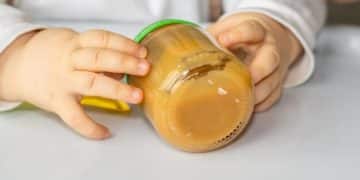Decoding Baby Food Labels: A 2025 Guide for Parents

Decoding baby food labels in 2025 involves understanding updated nutritional guidelines, recognizing allergens, and identifying potentially harmful additives, ensuring parents can make informed decisions for their baby’s health and well-being.
Navigating the baby food aisle can feel overwhelming. What do all those labels really mean? Decoding baby food labels: What you need to know in 2025 requires a proactive approach, considering evolving health standards and potential additives, empowering you to choose the best options for your little one.
Understanding the Basics of Baby Food Labeling
Baby food labels are designed to provide crucial information to parents. Understanding the basics can empower you to make informed choices about what you feed your baby. This section will cover the fundamental components of a baby food label.
Let’s explore the key elements that make up a standard baby food label.
Key Components of a Baby Food Label
Familiarizing yourself with these components is the first step toward becoming a savvy shopper.
- Ingredient List: Ingredients are listed in descending order by weight. The first few ingredients make up the majority of the product.
- Nutritional Information: This section details the nutrients provided per serving, including calories, fats, carbohydrates, and protein.
- Allergen Warnings: Manufacturers must declare common allergens, such as milk, soy, eggs, and peanuts, if they are present in the product.
- Expiration Date: This date indicates the product’s freshness and safety. Never feed your baby expired food.
By understanding these basics, you can begin to evaluate the quality and suitability of different baby food options.
In summary, understanding the basic components of a baby food label is crucial for making informed choices and ensuring the health and safety of your baby.
Navigating Nutritional Information in 2025
The nutritional information section of a baby food label is a treasure trove of data. Understanding how to interpret this information is vital for ensuring your baby gets the nutrients they need. This section will guide you through the key elements of nutritional information.
Let’s delve into the specifics of what you should be looking for.
Essential Nutrients to Look For
Focus on these essential nutrients to ensure your baby is getting a well-rounded diet.
- Iron: Crucial for brain development and preventing anemia. Many baby foods are fortified with iron.
- Calcium: Essential for strong bones and teeth. Found in dairy-based and fortified foods.
- Vitamin D: Helps the body absorb calcium and is important for bone health. Often added to baby food.
- Protein: Necessary for growth and development. Found in meats, beans, and dairy products.
Paying attention to these nutrients will help you make informed decisions about your baby’s nutritional needs.
Understanding the nutritional information on baby food labels is essential for providing your baby with a balanced and healthy diet, supporting their growth and development.
Identifying Hidden Sugars and Unhealthy Additives
Baby food labels can sometimes conceal hidden sugars and unhealthy additives. Being able to identify these ingredients is crucial for protecting your baby’s health. This section will highlight common hidden sugars and additives to watch out for.
Knowing what to avoid is just as important as knowing what to look for.
Common Hidden Sugars
These sweeteners can be detrimental to your baby’s health, contributing to weight gain and tooth decay.
- Corn Syrup: A cheap and highly processed sweetener.
- Maltodextrin: Another processed sweetener often used as a filler.
- Sucrose: Table sugar, which should be avoided in baby food.
- Fruit Juice Concentrate: While it sounds healthy, it’s a concentrated source of sugar.
Harmful Additives to Avoid
These additives can pose risks to your baby’s health and should be avoided whenever possible.
Avoiding hidden sugars and unhealthy additives is important for your baby’s health.
In conclusion, identifying hidden sugars and unhealthy additives on baby food labels is essential for safeguarding your baby’s health and well-being.
The Role of Organic and Non-GMO Labels
Organic and Non-GMO labels can provide assurance about the quality and safety of baby food. Understanding the significance of these labels can help you make more informed choices. This section will explore the meaning and benefits of organic and Non-GMO labels.
Understanding the difference can help you align your choices with your values.
Understanding Organic Labels
Organic labels ensure that the baby food is produced without synthetic pesticides, fertilizers, or genetically modified organisms (GMOs).
Organic labeling provides additional assurances about the quality and safety of baby food, offering peace of mind to parents who prioritize natural and sustainable options.
Decoding Non-GMO Labels
Non-GMO labels indicate that the baby food does not contain ingredients derived from genetically modified crops. Genetically modified crops are plants whose DNA has been altered through genetic engineering.
Non-GMO labeling reassures parents who are concerned about the potential long-term effects of GMOs on their baby’s health.
In summary, understanding the role of organic and Non-GMO labels can empower you to make choices that align with your values and ensure the quality and safety of your baby’s food.
Addressing Allergen Information on Baby Food Labels in 2025
Allergen information is a critical component of baby food labels, especially for parents with a family history of allergies. Knowing how to interpret this information can help protect your baby from allergic reactions. This section will guide you through understanding allergen warnings and precautionary statements.
Let’s explore the key elements to look for when assessing allergen risks.
Key Allergens to Watch For
These allergens account for the majority of food allergies in infants and young children.
Reading labels carefully and understanding allergen warnings can help you minimize the risk of allergic reactions and ensure your baby’s safety.
- Milk: A common allergen in infants. Look for casein, whey, and lactose in the ingredient list.
- Soy: Another frequent allergen. Watch for soy lecithin, soy protein isolate, and soybean oil.
- Eggs: Often found in baked goods and processed foods. Look for albumin, lecithin, and ovalbumin.
- Peanuts: A severe allergen for many individuals. Check for peanut flour, peanut oil, and hydrolyzed peanut protein.
Precautionary Statements
Precautionary statements indicate the potential presence of allergens due to cross-contamination during manufacturing. These statements may include phrases like “may contain” or “produced in a facility that also processes.”
In summary, carefully assessing allergen information on baby food labels is essential for preventing allergic reactions and safeguarding your baby’s health.
Understanding Expiration Dates and Storage Guidelines
Expiration dates and storage guidelines on baby food labels are crucial for ensuring the safety and freshness of the product. Ignoring these guidelines can expose your baby to harmful bacteria and toxins. This section will provide detailed information on how to interpret expiration dates and follow proper storage guidelines.
Let’s examine what these dates mean and how to store baby food properly.
Interpreting Expiration Dates
Expiration dates indicate the period during which the baby food is expected to remain fresh and safe to consume. These dates are usually printed as “use by,” “best by,” or “sell by.”
- Use By: This date is the most critical, indicating when the product should no longer be used.
- Best By: This date indicates when the product will be at its peak quality. It can still be safe to consume after this date, but the quality may decline.
- Sell By: This date is intended for retailers and indicates when the product should be removed from shelves.
Proper Storage Guidelines
Proper storage is essential for maintaining the safety and quality of baby food. Different types of baby food require different storage conditions.
By adhering to these storage guidelines, you can ensure that baby food remains safe and nutritious for your little one.
In summary, understanding expiration dates and following proper storage guidelines are vital for ensuring the safety and quality of baby food, protecting your baby from potential health risks.
New Labeling Regulations and What to Expect in 2025
Baby food labeling regulations are constantly evolving to ensure greater transparency and consumer protection. Staying informed about these changes can help you make even better choices for your baby. This section will discuss potential changes in labeling regulations expected in 2025.
Let’s explore what the future holds for baby food labeling.
Potential Changes in Nutrition Labeling
Future regulations may mandate more detailed nutritional information, including the amounts of added sugars, specific types of fats, and fiber content.
These potential labeling enhancements aim to provide parents with more comprehensive information, enabling them to make even more informed decisions about their baby’s diet.
Updates to Allergen Labeling
Regulations may expand the list of major allergens that must be declared on labels, and enforce stricter guidelines for precautionary statements. New labeling regulations may require manufacturers to provide more detailed information.
Staying informed about these emerging trends and potential regulatory changes can help you navigate the baby food aisle with greater confidence.
| Key Point | Brief Description |
|---|---|
| 👶 Ingredient List | Ingredients listed in descending order by weight. |
| 📊 Nutritional Information | Details nutrients per serving like fats, carbs, and protein. |
| 🚫 Allergen Warnings | Declares common allergens present in the product. |
| 📅 Expiration Date | Indicates product freshness and safety; never use expired food. |
Decoding Baby Food Labels: What You Need to Know in 2025
▼
Organic labeling means the food is produced without synthetic pesticides, fertilizers, or GMOs, offering a more natural option for your baby.
▼
Check for ingredients like corn syrup, sucrose, maltodextrin, and fruit juice concentrate to avoid added sugars in your baby’s food.
▼
Immediately discontinue use, seek medical attention, and carefully document the reaction to identify potential allergens.
▼
Non-GMO indicates the food doesn’t contain ingredients from genetically modified crops, reassuring parents concerned about GMO effects.
▼
Store baby food in the refrigerator or freezer as directed on the label, and always use clean utensils to prevent contamination.
Conclusion
In conclusion, decoding baby food labels in 2025 involves understanding nutritional information, identifying potential allergens and unhealthy additives, and staying informed about labeling regulations, empowering you to make informed decisions for your baby’s health and well-being.





